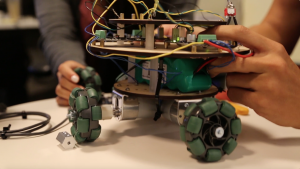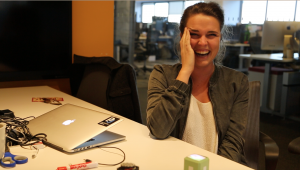Morgan Fabian is perhaps among the most naturally curious individuals you will ever meet. As the lead research engineer of the Applied Research team within the Digital Manufacturing Group at Autodesk, her job involves asking and answering an array of ever-evolving questions about each aspect of her projects.
Fabian’s team collaborates with customers and product teams to build proof of concepts for future manufacturing product offerings related to machine learning, the Internet of Things (IoT), and virtual reality. Here Fabian lets us in on what the future can hold for machine learning, IoT, and generative design.
What has your research team been working on recently? What have you learned?
I have spent a lot of the last 2 years investigating the impact of IoT on design and manufacturing. The term is ill-defined, but I like to think of IoT as the collection of technologies that now makes it cheap and easy to gather data about our physical world (and react or communicate back).
It’s a broad category, but IoT really shifts how we think about the role of designers in the future—so my team at Autodesk wanted to drill down into what exactly that was.
We built all kinds of things: a spherical robot that roamed around and sensed our San Francisco office space, and devices like a lamp that have physical and digital twins that have 2-way communication. We connected our software to the physical in unique and sometimes counter-intuitive ways, and brought real-time data into virtual reality environments for factories.
All these experiments led to a few general conclusions. Living in such a connected world, where everything in your life is being updated, synced, asking for your location, trying to provide the latest, most contextual information – it’s a lot to handle and a messy design problem with that. As all kinds of companies rush to connect their products, it’s sometimes not until we see the data that we realize we didn’t spend enough time thinking about what questions we want answered.
Designers need to start putting more forethought into how they gather information to guide the things we build. Armed with the right information, we can then design more efficiently, iterate faster, allow for broader customization, and have more purposeful products.
Designers have never had access to such a vast amount of information! It’s exciting—we haven’t even begun to take advantage of it.
What’s on the horizon?
Our team is focusing on machine learning moving forward. We have projects forming specifically around simulation and generative design. Simulation has an important intersection point with machine learning as it allows us to ask questions and get answers (a.k.a. data!) about what will happen in the real world.
You might have heard about self-driving cars using Graft Theft Auto to train their vision systems on all sorts of scenarios they might encounter. Autodesk has tools to create this for nearly every real-world scenario. Talk about a knowledge base waiting to be utilized.
Generative design builds off this idea, since it explores lots of options for designers, the computer for the first time becoming a collaborator in the design process.
Some cool stuff is in the works—stay tuned.
From your perspective, what role does machine learning play in the future of design?
One of the biggest areas of impact for machine learning will be opening up industry-specific knowledge—that companies take years to build expertise in—to a much broader audience. Knowledge transfer and specialization is a tough problem in design, but if we start to train our tools to have a sense for physics, predict the downstream costs of parts from a PLM system, know which factories are performing the best based on all the connected machines from IoT, then we won’t have to reinvent the wheel anymore.
I mentioned before that designers have never had access to such a huge amount of information. Well, neither have computers! Machines can collect so much more information to continually build off past designs, and not repeat mistakes. We’ll be better at saving money, make better decisions for the environment, and build things people love.
You’ve attended AU in 2015 and 2016. How have your AU experiences impacted your work? What have you gained through them?
AU is 1 of my favorite events of the year because I get to both meet with our customers and see what’s happening across the company. It’s a unique time where we really give the customers a platform to talk about what is top of mind for them—what they like about what they are seeing and what they don’t. It’s hugely valuable for a team like ours and has initiated a number of research collaborations to go after a vision they might have. There are also always other Autodesk teams that showcase things I haven’t heard about. So it’s a great way for me to connect dots and see how different technologies can solve multiple customer problems.
—
Morgan Fabian has held various design research roles since joining Autodesk in 2014. She received her B.S. in Industrial Engineering from UC Berkeley with a focus on systems and sustainable design. Check out more of her projects on How To Build a Smart Lamp and Building a Connected Robot.








(0)